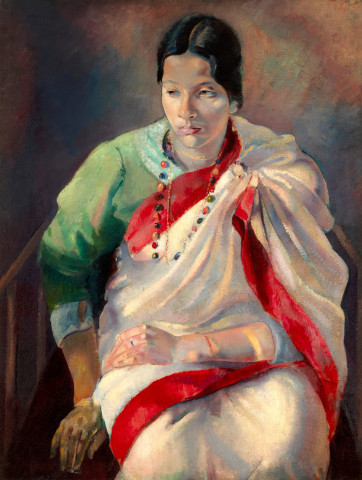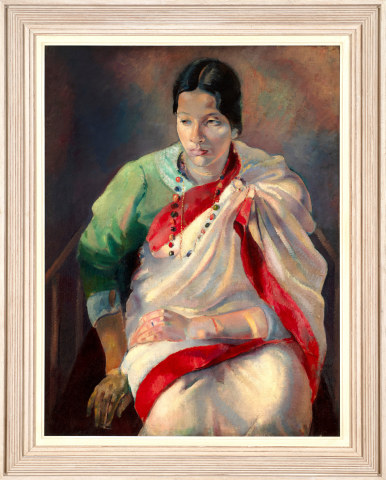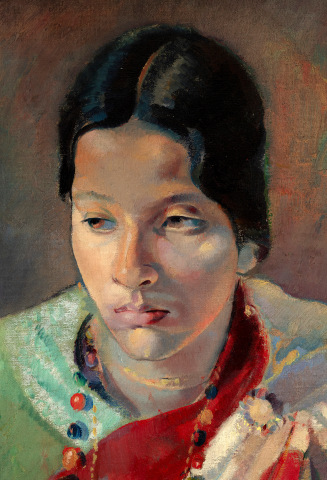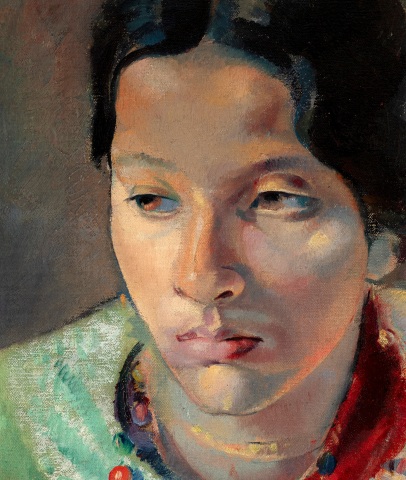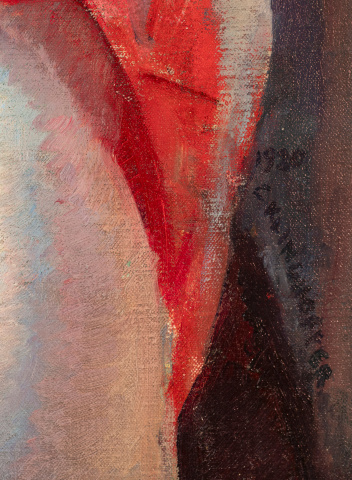Clara Klinghoffer
Portrait of the artist Pratima Devi Tagore (1893-1969)
Oil on canvas
100 x 76 cm
3P C
Further images
Download the catalogue note as a PDF here. Clara Klinghoffer's 1920 portrait of Pratima Devi Tagore (1893–1969), the Indian artist and daughter-in-law of the esteemed poet and social reformer Rabindranath...
Download the catalogue note as a PDF here.
Clara Klinghoffer's 1920 portrait of Pratima Devi Tagore (1893–1969), the Indian artist and daughter-in-law of the esteemed poet and social reformer Rabindranath Tagore (1861–1941), exemplifies the artist’s exceptional ability to blend realism with deep sensitivity. At a time when the art world was predominantly male-dominated, Klinghoffer’s portrayal of Pratima Tagore stands as a powerful intersection of female perspectives—an important example of one female artist capturing another. This dynamic enhances the contemporary significance of the portrait as we reassess the roles women played in society and their shared experiences navigating and asserting their presence within their cultural contexts in the early 20th century. Klinghoffer’s depiction of Pratima reveals a nuanced understanding of her subject’s inner life and societal role, reflecting the shared empathy and insight of two women deeply engaged in cultural and artistic expression at that time.
Protima Tagore, born Pratima Devi, was a Bengali artist and the daughter-in-law of the celebrated poet and philosopher Rabindranath Tagore. Pratima studied art under the renowned painter Nandalal Bose and Rabindranath Tagore himself, who encouraged her to pursue her artistic talents. She exhibited her work at the Indian Society of Oriental Art, run by the Tagore family, from 1915 onwards. Later, she moved to Paris, where she studied the Italian "wet fresco" method, further honing her skills.
Immediately after her marriage in 1910, Pratima, accompanied by her husband, lived for some time at the family estate in Shilaidaha, now in Bangladesh. She later returned to Santiniketan, following in the footsteps of her father-in-law and husband, immersing herself in the activities of Visva Bharati. Pratima was in charge of the dance curriculum at the music and dance school founded by Rabindranath Tagore in Santiniketan and is credited as one of the pivotal influences that shaped Tagore's dance-dramas in their early years. She had a remarkable ability to pick up new crafts and adapt them for the Silpa Sadan curriculum, contributing significantly to the educational initiatives at Santiniketan.
Pratima often accompanied her father-in-law on his travels, and they frequently visited Klinghoffer in her London studio. This portrait is the first of three works that Klinghoffer executed of Pratima, marking the beginning of a significant relationship between the artist and the Tagore family.
Klinghoffer began work on this oil portrait in 1919, interrupting other paintings to focus on Pratima sitting for her during her visit. The demure pose, with Pratima’s downcast eyes, suggests a modest and gentle character, contrasting with the finely modelled features of her face and hands. However, Klinghoffer employed looser, softer brushwork to capture the translucent folds of Pratima’s sari, creating a delicate, shimmering backdrop that contrasts with the more precise rendering of her features. This contrast highlights Klinghoffer’s skill in balancing different techniques within a single composition, allowing the viewer to appreciate both the physical likeness of the subject and the ethereal quality of the material world around her.
A later full-length portrait of Pratima was carried out in 1926, the year of Klinghoffer’s marriage to the Dutch journalist Joop Stoppelman. Stoppelman recalled Pratima coming to Clara's studio wearing a beautiful sari and glittering jewelry. That portrait is now in the Ben Uri collection, London, and became the first work by a woman artist to be acquired for the collection, marking an important milestone in the recognition of female artists.
Klinghoffer’s relationship with the Tagore family extended beyond mere portraiture. She and her husband often visited Rabindranath Tagore and Pratima at the Regina Hotel in Gloucester Road, where Tagore would discuss his works on philosophy and his educational initiatives in India. Tagore admired Klinghoffer’s work and even urged her to visit Santiniketan, his experimental school in Calcutta. While Pratima was often reserved during these visits, she became more at ease in the studio, sharing stories of her marital troubles and her eventful life traveling with her famous father-in-law.
This portrait, therefore, not only serves as a representation of Pratima Tagore but also as a reflection of the rich cultural exchange between East and West, and the profound personal connections that Klinghoffer forged through her art. The fact that the later painting of her in a Blue Sari was added to the Ben Uri collection underscores the importance of the present work within the artist’s oeuvre and within the broader context of early 20th-century portraiture.
Clara Klinghoffer's 1920 portrait of Pratima Devi Tagore (1893–1969), the Indian artist and daughter-in-law of the esteemed poet and social reformer Rabindranath Tagore (1861–1941), exemplifies the artist’s exceptional ability to blend realism with deep sensitivity. At a time when the art world was predominantly male-dominated, Klinghoffer’s portrayal of Pratima Tagore stands as a powerful intersection of female perspectives—an important example of one female artist capturing another. This dynamic enhances the contemporary significance of the portrait as we reassess the roles women played in society and their shared experiences navigating and asserting their presence within their cultural contexts in the early 20th century. Klinghoffer’s depiction of Pratima reveals a nuanced understanding of her subject’s inner life and societal role, reflecting the shared empathy and insight of two women deeply engaged in cultural and artistic expression at that time.
Protima Tagore, born Pratima Devi, was a Bengali artist and the daughter-in-law of the celebrated poet and philosopher Rabindranath Tagore. Pratima studied art under the renowned painter Nandalal Bose and Rabindranath Tagore himself, who encouraged her to pursue her artistic talents. She exhibited her work at the Indian Society of Oriental Art, run by the Tagore family, from 1915 onwards. Later, she moved to Paris, where she studied the Italian "wet fresco" method, further honing her skills.
Immediately after her marriage in 1910, Pratima, accompanied by her husband, lived for some time at the family estate in Shilaidaha, now in Bangladesh. She later returned to Santiniketan, following in the footsteps of her father-in-law and husband, immersing herself in the activities of Visva Bharati. Pratima was in charge of the dance curriculum at the music and dance school founded by Rabindranath Tagore in Santiniketan and is credited as one of the pivotal influences that shaped Tagore's dance-dramas in their early years. She had a remarkable ability to pick up new crafts and adapt them for the Silpa Sadan curriculum, contributing significantly to the educational initiatives at Santiniketan.
Pratima often accompanied her father-in-law on his travels, and they frequently visited Klinghoffer in her London studio. This portrait is the first of three works that Klinghoffer executed of Pratima, marking the beginning of a significant relationship between the artist and the Tagore family.
Klinghoffer began work on this oil portrait in 1919, interrupting other paintings to focus on Pratima sitting for her during her visit. The demure pose, with Pratima’s downcast eyes, suggests a modest and gentle character, contrasting with the finely modelled features of her face and hands. However, Klinghoffer employed looser, softer brushwork to capture the translucent folds of Pratima’s sari, creating a delicate, shimmering backdrop that contrasts with the more precise rendering of her features. This contrast highlights Klinghoffer’s skill in balancing different techniques within a single composition, allowing the viewer to appreciate both the physical likeness of the subject and the ethereal quality of the material world around her.
A later full-length portrait of Pratima was carried out in 1926, the year of Klinghoffer’s marriage to the Dutch journalist Joop Stoppelman. Stoppelman recalled Pratima coming to Clara's studio wearing a beautiful sari and glittering jewelry. That portrait is now in the Ben Uri collection, London, and became the first work by a woman artist to be acquired for the collection, marking an important milestone in the recognition of female artists.
Klinghoffer’s relationship with the Tagore family extended beyond mere portraiture. She and her husband often visited Rabindranath Tagore and Pratima at the Regina Hotel in Gloucester Road, where Tagore would discuss his works on philosophy and his educational initiatives in India. Tagore admired Klinghoffer’s work and even urged her to visit Santiniketan, his experimental school in Calcutta. While Pratima was often reserved during these visits, she became more at ease in the studio, sharing stories of her marital troubles and her eventful life traveling with her famous father-in-law.
This portrait, therefore, not only serves as a representation of Pratima Tagore but also as a reflection of the rich cultural exchange between East and West, and the profound personal connections that Klinghoffer forged through her art. The fact that the later painting of her in a Blue Sari was added to the Ben Uri collection underscores the importance of the present work within the artist’s oeuvre and within the broader context of early 20th-century portraiture.
Provenance
The estate of the artist, and by descent to 202316
of 16
